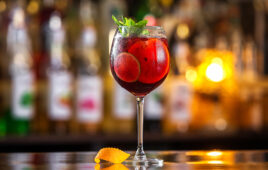
Club chefs are the ultimate maestros of culinary tightrope-walking, but when it comes to seafood, they take their balancing acts to new heights.
Certain ingredients—like salmon and scallops—must always be offered, but diverse options from the vast array of available seafood are becoming more prevalent in clubs across the country.
The menus at Marco Island, Fla.-based Hideaway Beach Club’s three restaurants feature a range of rotating seafood options for the club’s 1,300 members, including a sushi menu in the club’s lounge. Annual food-and-beverage revenue is $3 million, and seafood accounts for 47% of total sales.
“When something becomes available that members may not have seen, we try to bring it in and offer it on our fresh catch or daily features,” says Hideaway Executive Chef Timothy Smith.
Among the most successful species are parrot fish, Kona kampachi, triggerfish and any species of fresh grouper, such as yellow edge and strawberry, says Smith. Razor clams, however, “did not sell well.”
Smith changes 20% of each menu every three weeks, rotating through the restaurants, so every week is an opportunity to offer something new.
A bit of engineering has been necessary to overcome shortages, he adds. “Our menus change so frequently that we can work around shortages with each turn.”
Ocean’s Bounty
Mainstays on Hideaway’s menu include the grouper “Oscar” and lobster bisque.
According to Smith, sustainability always factors into his menu-writing. “We like to know where our ingredients come from, so we use responsible purveyors and stick to products we are proud to talk about,” he says, such as Verlasso salmon and yellowtail snapper from the Florida Keys.
Cost can be a challenge, Smith notes, but he and his staff have managed to mitigate most supply chain disruption.
“We rely on a large list of purveyors,” he says.
Over two years as Executive Chef of the 450-member Waldorf-Astoria Monarch Beach Resort in Dana Point, Calif., Jean-Pierre Dubray has tried to introduce more diverse seafood species to members, “but guests aren’t always willing to try unfamiliar items.”
Dubray says cod has fared relatively well—monkfish less so.
The resort has four restaurants, six bars and a large banquet facility. The annual food-and-beverage revenue is $60 million. The restaurants’ menus change twice a year, with year-round daily specials.
The resort’s Bourbon Steak restaurant features appetizers like ahi tuna tartare with Asian pear, pine nuts, Scotch bonnet, mint and sesame; and grilled Spanish octopus with chickpea purée, pomegranate glaze and ras el hanout. Entrées include Maine lobster pot pie with seasonal vegetables, brandied lobster cream, and broiled New Zealand tai snapper with ginger-scallion and fermented black beans.
Seafood items on the resort’s a la carte menus that Dubray considers permanent features are sea bass, salmon and crab.
Navigating Shortages
Like Dubray, Executive Chef Matt Maryjanowski says monkfish moves slowly at Brook-Lea Country Club (Rochester, N.Y.). However, he’s found success with black cod.
Permanent fixtures on the club’s menus are calamari, haddock fish fry and scallops, all of which help drive the club’s $1.8 million annual food-and-beverage revenue.
If availability issues arise, says Maryjanowski, members understand supply chain and pricing issues and give the culinary team leeway.
At Bentwater Yacht & Country Club in Montgomery, Texas, Executive Chef Timothy M. Oltz says he hasn’t “encountered any issues getting the fish we consistently buy, but sometimes, as we prepare for wine dinners, vendors will say they can get what we are requesting—then a week to five days before the event, it’s no longer available.”
Salmon and scallops are staples, says Oltz. And members “seem to enjoy redfish dishes of any sort” for Friday specials.
The club’s Crescent Grille & Patio features grilled mahi-mahi in a sauce of tomatoes, onions, olives, capers, garlic, lime and pickled jalapeño; seared sea scallops with a brown butter; and ancho-crusted salmon with yellow mole.




